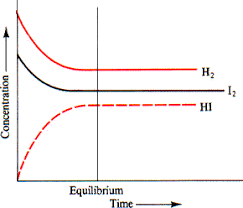Introduction
The dispersion of molecules of iodine 12 between immiscible liquids solvents, water, or carbon tetrachloride was used to estimate the molarity of the 12 substances involved at balance in the aqueous solution. The lack of information regarding activity coefficients for any complexes present complicates the investigation. Early scientists recognized the necessity to assume equal degrees of solubility for -iodide and polyiodide salts.
The iodine complex is a polyiodide system. It was researched longer than iodine reactions. Because little is known about starch and aqueous solutions containing Iodine and iodide, less is known about the starch-iodine reaction. Multiple sources describe varying levels of reaction.
Purpose
This experiment was designed to examine a typical reasonably homogeneous equilibrium in water and test the law of mass action. Equilibration happened when Iodine was combined with aqueous potassium iodide solutions: 12+1 = 1. (1) It is used to redistribute natural Iodine I between two immiscible solvents, water, and methylene chloride, to determine the equilibrium concentrations of the 12 species present in the aqueous solution. This experiment compares the solute distribution in the aqueous phase and CC14. It connects the concentration of 12 in two stages (12) and (I2) CCU.
Reagents
- Pipettes
- Distilled water (200 ml)
- 500-ml glass-stoppered Erlenmeyer flasks.
- Solutions of 12 in cci4 (50 ml)
- Clamped
- Battery jar containing water at 25°
- Using a pipette bulb
- Thermostat bath
Chemical formulas
The equilibrium conditions constant Kg, which must be stated in terms of the process of the different molecules involved, is approximated by the following equation involving concentrations: A are activities, y are activities coefficients, and K is the equilibrium constant to maintain optimally. (X) = Cyclo, in which cy is the number of moles of chemical X while co = 1 M.
k = (12) • I (12) CC14
K, = K comes from y = y and Yi, = 1. The estimated Debye-Hickel theory for ionic species activity coefficients at 25°C is! -0.507z? Y = – (3) +1 With the correctness of Eq., both lo and Iz have the same charges z and are affected by the same ionic strength 1. (3).
Experiment
- 50 ml 12 in CCI4 solutions was placed in 500 ml crystal Erlenmeyer flasks and allowed to equilibrate at 25°C.
- The flasks holding the solutions were shaken thoroughly for 5 minutes before clamping them in a thermostatic bath.
- After ten minutes of temperature equilibrium, the flasks were taken one by one and wrapped in a clean towel
- The flasks were aggressively shaken for three to five minutes and then replaced in the thermostat bath. This process was repeated for at least eight hours.
- After the last stirring, the flasks were placed in the boiling water bath to enable the fluid layers to completely separate. One flask was removed from the thermostatic bath then placed in a battery jar loaded with 25°C water after full equilibration.
- Pipettes were used to extract a sample of the aqueous layer or a portion of the CC14 layer. The flask was capped and reintroduced to the solution for a further 30 minutes of equilibrium with shaking as stated before, followed by a second specimen of each stage for titration.
Data analysis
Early researchers described this reaction exclusively for the dilution of Iodine in aqueous iodide solutions. The apparent change in the production constants of the triiodide ion in increasingly concentrated reactant solutions is still a mystery. The initial explanation proposed was that in slightly concentrated solutions, interactions involving iodine and iodide ions generated higher-order complexions. The experimental evidence supporting this claim is conflicting and often refers to solids rather than aqueous solutions. The study of species in solutions has indeed been ignored owing to the assumption that they encompass the very same complexes as those in solids.

Like Henry’s rule, this distribution law only applies to a particular chemical species. This indicates that the distribution variable k is not a natural thermodynamic equilibrium constant. Due to the comparatively high concentration for 12 in the CC14 phase, it is prudent to calculate kat various concentrations. When 12 is dispersed between CC14 and plain water, it may be measured immediately by titration. To produce (I2) in an aqueous solution containing 13′, titrate the 12 in a CCI4 layer equilibrated with this phase. The assumption is that the existence of ions in the aqueous solution phase does not affect the distribution constant’s value.

However, a more fundamental problem arises in that the identities of the complexes apart from triiodide that may occur in aqueous systems are unknown. Until the composition of these complexes is determined, no progress toward a quantitatively satisfying description of these solutions can be achieved. In light of a few good descriptions of pentaiodides, hepta-iodides, and sometimes even pentaiodides in the research, it has been implicitly believed that the ions found in solution are of the same general kind.
References
Garland, Nibler, & Shoemaker. Exp. 5: Chemical Equilibrium in Solution. Experiments In Physical Chemistry. 2021.